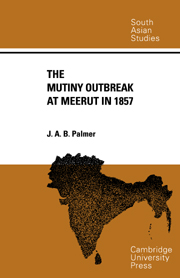Book contents
- Frontmatter
- Contents
- Introduction
- 1 CHAPĀTĪS
- 2 GREASED CARTRIDGES
- 3 THE PRESIDENCY DIVISION, FEBRUARY TO MAY
- 4 REGIMENTS AND OFFICERS AT MEERUT
- 5 MEERUT CANTONMENT IN 1857
- 6 THE FIRING PARADE OF 24 APRIL AND ITS SEQUEL
- 7 THE OUTBREAK: (a) The Native Infantry Lines
- 8 THE OUTBREAK: (b) The Native Cavalry Lines
- 9 THE OUTBREAK: (c) The Bazar Mobs
- 10 THE OUTBREAK: (d) The European Troop Movements and the European Lines
- 11 THE HANDLING OF THE EUROPEAN TROOPS
- 12 TO DELHI
- 13 CONCLUSIONS
- Notes and References
- Index
- Plan of Meerut Cantonment in 1857
8 - THE OUTBREAK: (b) The Native Cavalry Lines
Published online by Cambridge University Press: 24 October 2009
- Frontmatter
- Contents
- Introduction
- 1 CHAPĀTĪS
- 2 GREASED CARTRIDGES
- 3 THE PRESIDENCY DIVISION, FEBRUARY TO MAY
- 4 REGIMENTS AND OFFICERS AT MEERUT
- 5 MEERUT CANTONMENT IN 1857
- 6 THE FIRING PARADE OF 24 APRIL AND ITS SEQUEL
- 7 THE OUTBREAK: (a) The Native Infantry Lines
- 8 THE OUTBREAK: (b) The Native Cavalry Lines
- 9 THE OUTBREAK: (c) The Bazar Mobs
- 10 THE OUTBREAK: (d) The European Troop Movements and the European Lines
- 11 THE HANDLING OF THE EUROPEAN TROOPS
- 12 TO DELHI
- 13 CONCLUSIONS
- Notes and References
- Index
- Plan of Meerut Cantonment in 1857
Summary
The 3rd Light Cavalry was the regiment directly involved in the firing parade and its consequences and one would have expected that, when the outbreak came, it would have begun among them: indeed the outbreak is often vaguely ascribed to them, with the implication that the native infantry joined in. It comes as somewhat of a surprise to find that the evidence points to the disturbance in the cavalry lines having followed, not preceded, that in the infantry lines. This seems to be indicated, somewhat obscurely, by two out of the three deponents from the cavalry regiment. More significant, perhaps, is the fact that none of the infantry deponents alleges that the infantry broke out following upon some disturbance in the cavalry lines, and if the facts had not been notoriously against it this would surely have been suggested: as it is, all infantry witnesses make their outbreak follow upon the bazar outcry and do not mention the cavalry at all. Once the cavalry had risen, they took to their horses, and the consequence is that their actions then ranged farther and moved faster than those of the infantry. This increases the difficulty of co-ordinating in point of time what was occurring in the native infantry and cavalry lines respectively.
There is no clear statement about the initial stages of the outbreak of the cavalry. It seems to have started about 5.30 p.m., even a little after, the time when the officers of the 20th N.I. were getting down to the lines.
- Type
- Chapter
- Information
- The Mutiny Outbreak at Meerut in 1857 , pp. 80 - 87Publisher: Cambridge University PressPrint publication year: 1966



